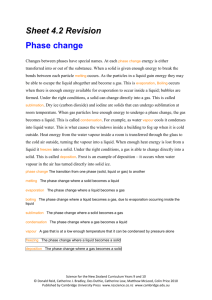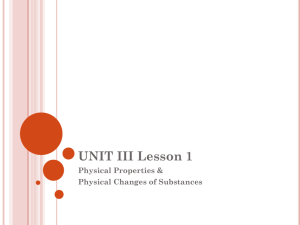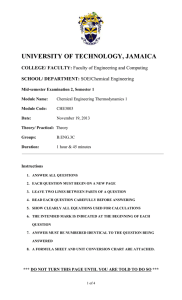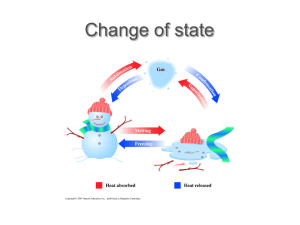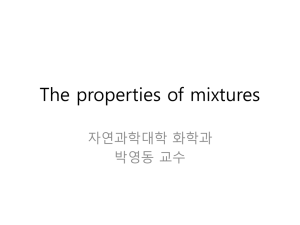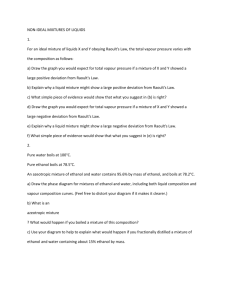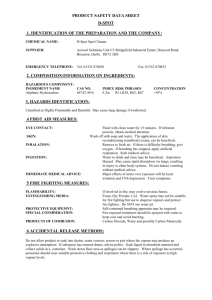phase equilibrium1
advertisement
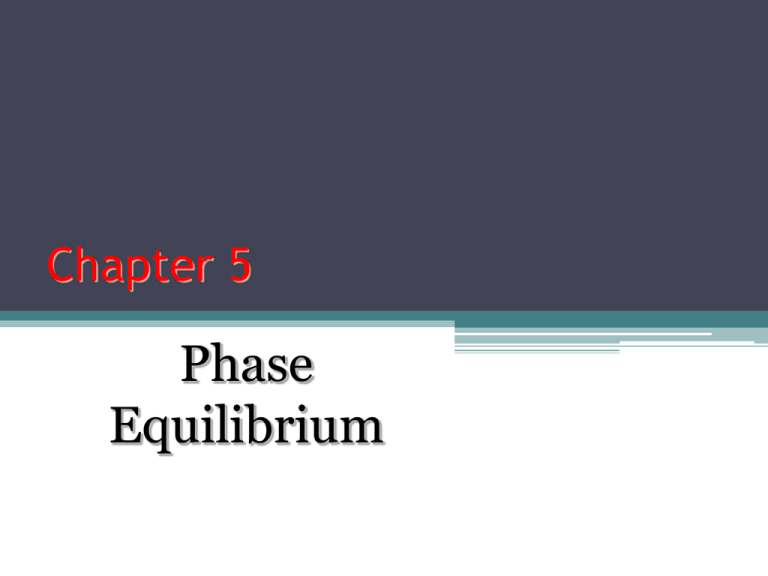
Chapter 5 Phase Equilibrium • Phase- part of a system which is chemically and physically uniform throughout oil • Symbol P = number of phase Phase boundary • Three phase of state: ▫ Solid ▫ liquid ▫ gaseous water Figure: 2 phase system with phase boundaries -mixture of oil and water not homogent and have a phase boundary • Example; ▫ solution of sugar in water one phase: liquid ▫ Mixture of gases one phase: gaseous ▫ Mixture of ice and water two phases: solid & liquid) ▫ Oil and water two phases: liquid & liquid) ▫ Saturated solution with an excess of insoluble solute two phases: solid & liquid • Plot showing effect on pressure and temperature on physical state substances@ graphical representation of the conditions of temperature and pressure at which the solid, liquid and vapour (gas) exist, either as a single/two or more phases in equilibrium • Uses - to predict physical state at specific temperature and pressure • Each part in phase diagram represent different things: area/ region = phase line = set of temperature and pressure which 2 phase on either side of line exist in equilibrium Triple point, O = condition of temperature and pressure at which all 3 phases of a substances coexist at equilibrium Vapour pressure/atm Liquid Solid E Vapour Temperature/oC - example • The phase diagram for a substances A is shown. State the physical state of A at the condition X, Y and Z x P liquid solid z O y vapour T Solution: At condition x compound A exist as solid and liquid in equilibrium At condition y liquid A and gas/ vapour A exist in equilibrium At condition z substances A exist as a solid only The general form of phase diagram and various changes of state from one phase to another Pressure (atm) water C B ice vapour O A Temperature (ºC) One Component System The phase diagram of water • Water exist as solid (ice), gas (water vapour) and also liquid (water) Pressure (atm) C B 200 water ice 1.0 O 0.006 vapour D A 0 0.01 100 374 Temperature (ºC) The phase diagram of water Pressure (atm) C 200 B water ice 1.0 O 0.006 vapour D A 0 0.01 100 374 OB = vapour pressure curve (show the vapour pressures of water changes with T. Also summarised the conditions of T and P under which liquid water and water vapour are in equilibrium) B = Critical point which critical temperature = 374 ºC & critical pressure = 200 atm. (The upper limit of OB, beyond which liquid and vapour phases cannot be distinguished. There are no longer two separate phase, Temperature because densities of the gas and (ºC) liquid are equal. At temperature higher than the critical temperature, water vapour cannot be changed into liquid water even though a high pressure is used.) The phase diagram of water AO = vapour pressure curve for ice / sublimation curve (show the vapour pressures of ice varies with T. Also summarised the condition under which solid ice and water vapour can be equilibrium) Pressure (atm) C 200 B water ice 1.0 O 0.006 vapour D A 0 0.01 100 374 Temperature (ºC) O = Triple point which ice, water, water vapour exist in equilibrium at 0.01ºC & 6.03 x 10-3atm) The phase diagram of water OC = melting temperature curve (show the effect of pressure on the melting point of ice or the freezing point of water. Line slope to left : P high, m.p decreases) OD = Supercooling (vapour pressure of water below its freezing point. Metastable condition because water is not liquid below freezing point. Pressure (atm) C 200 B water ice 1.0 O 0.006 vapour D A 0 0.01 100 374 Temperature (ºC) The phase diagram of Carbon dioxide • Basically phase diagram for CO2 is the same as phase diagram for H2O except for two things. Pressure (atm) C B 217 liquid solid 5.1 O vapour D 1.0 A -78 -57 374 Temperature (ºC) The phase diagram of carbon dioxide Pressure (atm) C B 217 liquid solid 5 . 1.0 1 O vapour D A -78 -57 374 OB = Liquid & vapour in equilibrium , pressure high, temperature high B = Critical point which critical temperature = 374 ºC & critical pressure = 217 atm. temperature high, kinetic energy, vapour high, pressure high will change vapour to liquid 374 ºC is the highest temperature at which CO2 gas can be liquefied (critical temperature) Temperature 217 atm is highest pressure at (ºC) which CO2 gas can be liquefied (critical pressure) O = Triple point ( T= -57ºC, P= 5.1 atm) at which CO2 can exists as solid , liquid and gas Comparing the phase diagram for water and carbon dioxide Z Vapour pressure/atm Y 200 Solid H2O(s) 0.006 Liquid H2O(l) Z Y 218 Liquid Solid E X 5.0 Vapour H2O(g) E 1.0 Vapour X B 0.01 374 Temp(oC) -78 -57 374 Temp/oC Differences between phase diagram of CO2 and water 1. Triple point O is above the atmospheric pressure (-57ºC, 5.1 atm). So, solid CO2 sublime to gaseous CO2 below 5.1 atm, while liquid CO2 only exist above than 5.1 atm, with temp greater than -57ºC 2. OC line slopes to the right for CO2 and for most substances : pressure high, melting point high • Phase diagram of water slope (-ve) ▫ Substance is more dense as liquid than its solid (ice is less dense than water), liquid is more compact than than the solid ▫ Increasing pressure which will favor the compactness of the molecules, will thus favor the liquid state ▫ Increasing pressure will thus lower the temperature at which the solid will melt ▫ At high pressure, melting point decreases • Phase diagram of most substances, eg CO2 slope (+ve) ▫ Substance is more dense is more dense as a solid than it is as a liquid ▫ Increasing pressure which will favor the compactness of the molecules, will thus favor the more dense solid phase ▫ Higher temperature are required to melt the solid phase at higher pressure Uses of Dry ice (solid CO2) in industry Used in food industry as a refrigerant because it is very cold and does not leave a messy liquid when sublimes Dry ice is used for cloud seeding. It is spread into the cloud to accelerate rain fall Also used in film or stage performances to produce special effect involving a cloud or a mist • The phase rule can enable a chemist to make some prediction about the possible outcome of changing conditions • The Phase Rules describes the possible no. degree of freedom or no of variables (eg: T, P, conc) which can be varied independently without changing the no. of phases in a (closed) system at equilibrim. • It is expressed as: P+F=C+2 where, P = the number of phases C = the number of component F = the number of degrees of freedom/ the minimum number of variables (e.g pressure, temperature required to characteristic the phase) • When C is increase, F will increase • When P is increase, F will decrease 18 • Constituent- a chemical species (ion or molecule which is present • Component (C) - chemically independent constituents of a system ▫ C = #of independent chemical constituents - # of distinct chemical reactions #of independent chemical constituents = total # of constituents minus the number of any restrictive conditions (charge neutrality, material balance etc.) Example 1: CaCO3(s) CaO(s) + CO2(g) ▫ Phases: P = 2 solid + 1 gas = 3 ▫ Component: C = 3 consitiuents - 1 reaction = 2 example • Calculate number degrees of freedom, F for every part below: Pressure (atm) C liquid B O solid A Solution: Area COB : P + F = C + 2 1+F=1+2 F=3–1=2 Line OC : P + F = C + 2 2+F=1+2 F=3–2=1 vapour Temperature (ºC) Point O : P + F = C + 2 3+F=1+2 F=3–3=0 20 One Component Systems • Phase rule says that you can have at most 3 phases ▫ F = C – P + 2; C=1 F=3–P • If P=3, F=0 system is invariant ▫ Specified by temperature and pressure and occurs at 1 point (called the triple point) there is only 1 temperature & 1 pressure where all 3 phases of water in eqbm • If one phase is present, F = 2 that is P and T can be varied independently ▫ This defines an area in a P,T diagram which only one phase is present • If two phases are present, F = 1 so only P or T can be varied independently. ▫ This defines a line in a P, T diagram ▫ Varying the temperature necessitates the specific changes in the temperature One component phase diagrams Two components system- mixture of two miscible liquids • Vapour pressures of solutions (vapour pressure pressure of a vapour in thermodynamic eqbm with its condensed phase in a closed system) 1. When a pure liquid is placed in a covered container, the vapour pressure of the pure liquid will increase gradually. 2. When equilibrium is achieved, the vapour pressure is at maximum and is called saturated vapour pressure of the liquid. 3. When the built up vapour pressure of the liquid equals to the external pressure (ie 1atm or 760 mmHg), the liquid will boil Liquid mixtures. • A miscible solution mixture is a homogeneous mixture of two different liquids, A and B. • Examples : mixtures of methyl benzene with benzene, ethanol and water. • An immiscible solution mixtures is a solution when mixed the components remain segregated in a heterogeneous mixture. • Example : benzene and water • carbon tetrachloride and water Vapour pressure of a solution • The total vapour pressure of a solution is the sum of the vapour pressure of each component that make up the solution Psolution = PA + PB where Psolution = the total vapour pressure PA = partial pressure of component A PB =partial pressure of component A Roult’s law PA = XAPA * Ideal solution and non ideal solution • A solution that obeys Roult’s law is called ideal solution • An ideal solution is a mixture of two solutions A and B where i) the intermolecular forces of attraction between the A and B molecules are of the same type and of equal strength. [ forces between A…A is the same as A…..B or B….B] ii) the total volume of solutions A and B when mixed remains unchange [ 50 mL of A when added to 50 mL of B gives 100 mL solution] Examples: benzene + methylbenzene 2-methylpropanol + propanol hexane + heptane VAPOR PRESSURE-COMPOSITION VAPOR PRESSURE-MOLE FRACTION Vapour pressure Po B PT Po A XB XA XA XB • Component with high vapour pressure means that its boiling point is low. • SO REMEMBER! HIGH VAPOUR PRESSURE = LOW BOILING PT LOW VAPOUR PRESSURE = HIGH BOILING PT vapour pressure -composition curves & boiling point -composition curve B.p (ºC) Boiling point. (at constant P) Vapour pressure. (at constant T) P XB XA XB XA The vapour pressure versus mole fraction curve/diagram is opposite to the boiling point vs mole fraction • VAPOUR PRESSURE VS COMPOSITION BOILING POINT VS COMPOSITION T1 Vapour Liquid T2 Liquid Vapour Pure A X3 X2 T2 X3 Pure B Pure A X3 X2 X3 Pure B Deviation from Raoult’s Law • Raoult's Law only works for ideal mixtures. In these, the forces between the particles in the mixture are exactly the same as those in the pure liquids. The tendency for the particles to escape is the same in the mixture and in the pure liquids. • That's not true in non-ideal mixtures. 31 Deviation from Ideality • Extreme deviations from ideality ▫ Result in maxima /minima in vapour-pressure diagrams and temperature- composition diagrams AZEOTROPES a – without zeo- boil Trops - change Means composition does not change during boiling Azeotropic Mixture: Mixture of two miscible liquids that has a constant boiling point and the vapour that exist in equilibrium with the liquid has the same composition as the liquid On heating an azeotropic mixture until it boils, the vapor liberated has the same composition as the original liquid mixture POSITIVE DEVIATION • In mixtures showing a positive deviation from Raoult's Law, the vapour pressure of the mixture is always higher than that of an ideal mixture, Explaining positive deviations • The fact that the vapour pressure is higher than ideal in these mixtures means that molecules are breaking away more easily than they do in the pure liquids. • That is because the intermolecular forces between molecules of A and B are less than they are in the pure liquids. • A-A ~ B-B > A-B in which bond A-B is weaker. So, vapour pressure is greater than predicted by Raoult’s Law -tendency molecules to escape is greater POSITIVE DEVIATION Boiling point Vapour Pressure Liquid Azeotrope PoA =1 TB =1 Liquid Vapour Vapour XB=1 Composition TA =1 Liquid Vapour PoB =1 Vapour Liquid Azeotrop e XA =1 XB=1 Composition XA =1 Negative deviation Explaining negative deviation • These are cases where the molecules break away from the mixture less easily than they do from the pure liquids. New stronger forces must exist in the mixture than in the original liquids • A-A ~ B-B < A-B in which bond A-B is stronger. So, vapour pressure is lower than predicted by Raoult’s Law -tendency molecules to escape into the vapour phase decreased NEGATIVE DEVIATION Vapour Pressure Boiling point Po A =1 Azeotrope Liquid Liquid Vapour Vapour Vapour TB =1 Azeotrope XB=1 Composition Liquid Vapour Liquid TA =1 XA =1 XB=1 Composition XA =1 Distillation of an ideal solution T1 Vapour Liquid Pure A X3 X2 T2 X1 Pure B • When the composition of the mixture X1 is heated, it boils at a temperature T1 to provide a vapour that has a composition X2. • If this vapour is condensed and then reheated, it will boil at a temperature T2 and give a vapour whose composition is X3 • Repetition of this process will produce fraction richer in A. This procedure is called fractional distillation and is useful not only in laboratory – to purify products of chemical reactions – but also in industrial sectors such as in the petroleum industry. • There some solution cannot be totally separated into their components by fractional distillation (e.g ethanol-water mixture). Distillation of non ideal mixture ETHANOL –WATER MIXTURE • Suppose a mixture of ethanol and water with composition C1 is heated. It will boil at a temperature given by the liquid curve and produce a vapour with composition C2. • When that vapour condenses it will, of course, still have the Azeotropic Mixture: Mixture of two miscible liquids that has a constant boiling point and composition C2. If you the vapour that exist in equilibrium with the reboil that, it will produce liquid has the same composition as the liquid On heating an azeotropic mixture until it boils, a new vapour with the vapor liberated has the same composition C3. composition as the original liquid mixture Distillation of solution Non Ideal solution -positive deviation B.p (ºC) A B Boiling point. (at constant P) 80 ºC T1 78.5 ºC T2 X1 X2 100% benzene X4 azeotropic X3 100% ethanol • If solution in section A (composition X1) is subjected to fractional distillation, solution will boil at T1 and the vapour liberated will have composition X2. • This vapour contain a higher percentage of ethanol than in original mixture. • The vapour liberated undergoes condensation and vapourisation and finally an azeotropic mixture is obtained and distils over. B.p (ºC) A • If solution in section B (composition X3) is subjected to fractional distillation, the solution boils at T2 and the vapour that escapes has the composition X4, that is richer in benzene. B Boiling point. (at constant P) 80 ºC T1 78.5 ºC T2 X1 X2 100% benzene X4 azeotropic X3 100% ethanol • The more volatile component, that is, the azeotropic mixture with the lower boiling point, is distilled first. As distillation proceeds, the concentration of ethanol in the residual liquid increases. Finally the temperature of the residual liquid reaches 78.5ºC and pure ethanol distills over Distillation of solution • If solution in section B (composition Non Ideal solution -negative deviation B.p (ºC) A • B 121 T1• Boiling point. (at constant P) T2 100 78 • X2 100% H20 X1 X3 Azeotropic 68.2% HNO3 100% HNO3 X1) is subjected to fractional distillation, solution will boil at T1 and the vapour liberated will have composition X3. This vapour contain a higher percentage of HNO3 than in original mixture and decreased in the residual liquid. The vapour liberated undergoes condensation and vapourisation and finally a pure HNO3 is obtained as first distillate. As distillation proceeds, the residual liquid in the distillation flask become richer in water and its boiling point increases. This continues until the solution contain 68.2% HNO3 when the mixture distils unchanged at 121ºC. The mixture that contains 68.2% HNO3 is known as azeotropic mixture. Simple distillation • Would still produce mixture (not effective to separate ideal solution to pure component) Fractional distillation • Separation is better because it can separate A completely from B (for ideal/approximately ideal solution) • Processes is in one continuous operation • Fractionating column is a long tube filled with glass beads or short pieces of glass tubing so that can provides a large surface area which condensed liquid and ascending vapour can have maximum contact. AZEOTROPIC MIXTURE • • • Azeotropic Mixture: Mixture of two miscible liquids that has a constant boiling point and the vapour that exist in equilibrium with the liquid has the same composition as the liquid On heating an azeotropic mixture until it boils, the vapor liberated has the same composition as the original liquid mixture An azeotropic mixture cannot be separated into its component through fractional distillation. The separation of the two components in an azeotropic mixture can only be carried out using the following methods: a) Using a third component -an azeotropic mixture of ethanol and water can be separated if benzene is added to the mixture (benzene/water-pure ethanol) b) Using a chemical method –usage of CaO to absorb water c) Using an adsorbent like charcoal or silica gel d) Using solvent extraction COOLING CURVE FOR PURE COMPONENT (Pure Pb) Constructing the phase diagram PHASE DIAGRAM Liquid Pb + liquid Sn Solid Pb + liquid mixture Solid Sn + liquid mixture Solid Pb + Solid Sn EUTECTIC SYSTEM • If a liquid of composition Y (Cy) is cooled, the pure B component begin to settle out when temperature Ty is reached. The liquid Y becomes richer in A as the temperature falls and pure B continually separates out, until the eutectic temperature is reached, when the remaining liquid crystallizes out without further change in temperature • A similar situation occurs with a mixture of composition Z (CZ), but now, it is pure A that settles out until the eutectic is reached • If a liquid mixture of the eutectic composition is cooled, it freezes at the constant eutectic temperatures giving a solid with the same composition as the liquid (resembling a pure substances) EUTECTIC SYSTEM • Solid present as separate phases (e.g ice and salt) Temperature X y Melting point pure B z Ty liquid Melting point pure A Solid A + liquid Solid B + liquid Eutectic point Solid A + eutectic Pure A Solid B + eutectic CZ XA Pure B Cy Eutectic composition XB Mole fraction EUTECTIC SYSTEM The composition of the liquid mixture changed during the cooling process due to the increased formation of solid phase Solid B formed 80 ºC 80 % B 20 % A 25 ºC 40 % B 60 % A Liquid composition 65 ºC 70 % B 30 % A 50 ºC 60 % B 40 % A Liquid composition after B Solid is formed EUTECTIC SYSTEM • The eutectic is not a compound because : a) The eutectic can be seen to be heterogenous under the microscope, whereas a compound would be heterogenous b) The composition of a eutectic rarely corresponds to that of a compound c) The properties of the eutectic, e.g. its heat of solution, are actually the sum of the properties of its constituents. This is very likely for a true compound Reference: Advance Physical Chemistry (1976), A. Holderness, Heinemann Educational Publisher, Oxford DISTRIBUTION OF A SOLUTE BETWEEN TWO SOLVENTS THE DISTRIBUTION LAW • When a solute is added to two immiscible liquids, it may dissolve in both liquid. In this case the solute will distribute itself between the two solvents • The ratio in which it is distributed is govern by the distribution law. This states that at constant T, a solutes distribute itself between two immiscible liquids in a constant ratio of concentration irrespective of the amount of solute added solute Two immiscible liquids Shaken-up The molecules of solutes being distributed into the two layers DISTRIBUTION OF A SOLUTE BETWEEN TWO SOLVENTS • Consider the distribution of iodine between water and tetrachloromethane (two immiscible liquids). If we shake up iodine with these two solvents, some will dissolve in the water and some in the CCl4. Eventually a dynamic equilibrium is established I2 (water) I2(CCl4) At equilibrium, the rate of I2 passes from CCl4 to water= rate of I2 passes from water to CCl4 • No matter how much iodine we use, the ratio of the final concentrations is constant. The constant is called the partition (distribution) coefficient, k K = [I2 (CCl4) ] or K= [I2 (aq) ] [I2 (aq) ] [I2 (CCl4) ] • The whole equation is called ‘Distribution Law’ DISTRIBUTION OF A SOLUTE BETWEEN TWO SOLVENTS • • The law only holds under certain conditions: a) The temperature must be constant b) The two solutions must be reasonably dilute c) The solute must not react, associate or dissociate in the solvents For example, the distribution coefficient, k for benzoic acid in benzene and water increases with increasing concentrations in the two layers (at constant T). This is due to the formation of benzoic acid dimers in the benzene layer. These dimers are formed as a result of hydrogen bonding. O C-OH Molecules associates O C-OH Hydrogen bonding in organic phase Benzene (organic) Water (aques) APPLICATIONS OF THE DISTRIBUTION LAW SOLVENT EXTRACTION • In this method, two immiscible liquids are used as the selective solvents for components in a mixture. The mixture is shaken with the two immiscible liquids. The liquids are then allowed to separate. Each layer is then subjected to a number of extractions with the other solvent • An example of solvent extraction is ether extraction. This is used to separate the organic compounds from the aqueous solution. • The ether layers are combined and the solvent (ether) is evaporated off to leave the organic material • This technique is particularly useful when the product is volatile or thermally unstable APPLICATIONS OF THE DISTRIBUTION LAW Shaken-up Separate ether layer ether Aqueous Aqueous containing organic compound Aqueous Aqueous layer further extract with fresh ether No organic compound remain in aqueous layer fresh ether Aqueous MULTIPLE SOLVENT EXTRACTION • Repeated extractions using small portions of solvent are the most efficient than using a single but larger volume of solvent • Example: The product of an organic synthesis 5 g of X obtained in solution in 1000 ml of water. Calculate the mass of X that can be extracted from the aqueous solution by: A) 50 ml of ether B) Two succesive portions of 25 ml of ether The partition coefficient of X between ether and water is 40 at room temperature. a) volume of ether = 50 ml volume of water = 1000 ml 1 time extraction mass of X in water = 5 g Let the mass of X extracted by 50 ml ether M X in ether 40 k X in water 1 (X is an organic compound, therefore it easily dissolved in ether as compared to water if M g dissolved in ether, than (5 - M) g remains in aqueous. Substituti ng into the Distributi on Law : M 50 ml 40 1 5M 1000ml M 3.33 g The mass of M that can be extracted by using all the ether at once is 3.33 g 50ml ether After 1000ml water 5 extraction M 5-M b) volume of ether = 25 ml volume of water = 1000 ml mass of X in water = 5 g 2 time extraction Let M mass of X extracted by first 25 ml ether 1 M mass of X extracted by second 25 ml ether 2 k X in ether 40 X in water 1 25 ether M 1 25 ml 1000 40 water 1 5M 1 1000ml M 2.50 g 1 if 2.50 g of X are extracted by ether, 2.50 g remain in the aqueous. Therefore : M 25 ether 2 25 ml 40 1000 1 2.5 M 2 water 1000ml M 1.25 g 2 Total mass of X extracted by ether in two portions is (2.50 1.25 ) 3.75 g. So, repeated extraction s using small portions of solvent (25 ml x 2) are more efficient than using a single but larger vol ume of solvent (50 ml) After extraction 5 M1 5 – M1 2.5 After extraction 2.5 M2 2.5 – M2 • V cm3 of a solution which contains W0 g of a solute is extracted repeatedly with equal portions of S cm3 fresh organic solvent which is immicible in water S cm3 V cm3 W0 After extraction W0-W1 W1 S cm3 V cm3 Let W1 mass of solute remains in the aqueous layer after the first extraction W1 gcm 3 v W - W1 concentrat ion of the solute in the organic phase 0 gcm 3 S By Distributi on Law : concentrat ion of the solute in the aqueous phase W1 Concentrat ion of the X in aqueous phase v k Concentrat ion of the X in organic phase W0 - W1 S W1 v k W0 W1 S W1S k v(W 0 W1 ) W1S Kv(W0 W1 ) kvW 0 kvW1 W1S kvW1 kvW 0 W1 (kv S) kvW 0 kv W1 W0 kv S Let W 2 mass of the solute that remains in the aqueous layer after second extraction W2 v kv k W2 W1 kv S W1 W2 S substituti on W1 above in W 2 : 2 kv kv kv W2 W0 W0 kv S kv S kv S if the mass of the solute that remains in the aqueous layer after n times extraction is Wn , it follow that : Wn kv kv S n W0 For multiple extraction if k concentrat ion of organic phase concentrat ion of aqueous phase n v Wn W0 v ks where;Wn mass of solute remain in aqueous layer after n time extraction W0 initial mass of solute in aqueos layer before extraction n number of extraction v volume of aqueous phase s volume of organic phase k concentrat ion of aqueous phase concentrat ion of organic phase n kv Wn W0 kv s a) volume of ether, s = 50 ml volume of water, v = 1000 ml mass of X in water, W0 = 5 g 1 time extraction, n = 1 if k X in ether 40 X in water 1 n v Wn W0 v ks 1 1000 5 1000 (40)(50) 1.6 g so, mass of solute in organic (ether) layer 5 - 1.6g b) volume of ether, s = 25 ml volume of water, v = 1000 ml mass of X in water, W0 = 5 g 2 time extraction, n = 2 if k 3.33 g X in ether 40 X in water 1 n v Wn W0 v ks 2 1000 5 1000 (40)(25) 1.25 g so, mass of solute in organic(et her) layer 5 - 1.25 g 3.75 g
